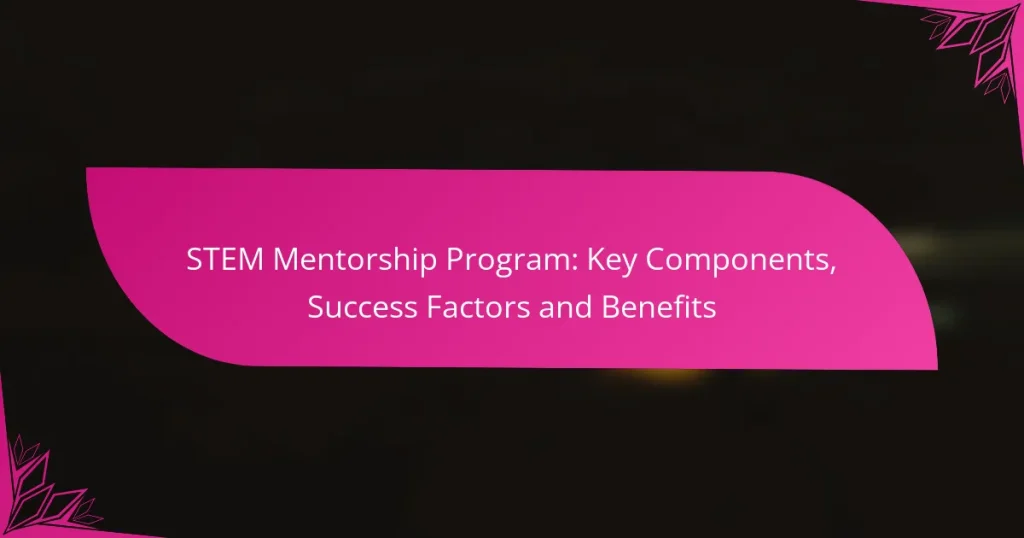A STEM mentorship program is designed to provide essential guidance and support to mentees, fostering meaningful engagement and growth in science, technology, engineering, and mathematics fields. By connecting mentees with experienced professionals, these programs offer valuable resources and insights that contribute to career advancement, academic success, and personal development. Key success factors, such as mentor commitment and effective communication, play a crucial role in enhancing the mentorship experience.

What are the key components of a STEM mentorship program?
A STEM mentorship program typically includes several essential components that facilitate effective guidance and support for mentees. These components ensure that both mentors and mentees can engage meaningfully, fostering growth in STEM fields.
Mentor-mentee matching process
The mentor-mentee matching process is crucial for the success of a STEM mentorship program. It involves assessing the interests, skills, and goals of both parties to create compatible pairings. Effective matching can enhance communication and ensure that the mentorship is relevant and beneficial.
Programs often use surveys or interviews to gather information about potential mentors and mentees. This data helps coordinators make informed decisions, increasing the likelihood of a productive relationship.
Structured curriculum and resources
A structured curriculum provides a framework for the mentorship experience, outlining key topics and skills to be covered. This curriculum should be tailored to the specific needs of the mentees, incorporating hands-on activities, workshops, and relevant resources.
Resources may include access to online courses, research materials, and industry tools. Providing these materials helps mentees gain practical knowledge and experience, which is essential for their development in STEM fields.
Regular feedback and evaluation
Regular feedback and evaluation are vital for tracking progress and making necessary adjustments in the mentorship process. Scheduled check-ins allow mentors and mentees to discuss achievements, challenges, and areas for improvement.
Implementing evaluation metrics, such as goal completion rates or skill assessments, can help measure the effectiveness of the mentorship. This ongoing assessment ensures that the program remains dynamic and responsive to the needs of participants.
Networking opportunities
Networking opportunities are an integral part of a STEM mentorship program, as they connect mentees with professionals in their field. These connections can lead to internships, job opportunities, and collaborations that enhance career prospects.
Programs should facilitate networking through events, workshops, and online platforms where mentees can interact with industry experts. Encouraging mentees to build their professional network is essential for long-term success in STEM careers.
Goal-setting frameworks
Goal-setting frameworks help mentees define clear, achievable objectives throughout their mentorship journey. Establishing specific, measurable, attainable, relevant, and time-bound (SMART) goals can guide the focus of the mentorship and provide motivation.
Mentors should assist mentees in developing these goals and regularly revisit them to assess progress. This structured approach not only fosters accountability but also enhances the overall effectiveness of the mentorship experience.

How do STEM mentorship programs benefit participants?
STEM mentorship programs provide numerous advantages for participants, including career growth, academic enhancement, and personal development. These programs connect mentees with experienced professionals who offer guidance, resources, and insights tailored to their fields.
Enhanced career development
Mentorship programs significantly boost career development by providing mentees with networking opportunities and industry connections. Participants often gain access to job openings, internships, and professional events that may not be available otherwise.
Additionally, mentors can offer personalized advice on career paths, helping mentees identify their strengths and interests. This guidance can lead to more informed decisions about education and career trajectories, ultimately enhancing job prospects.
Improved academic performance
STEM mentorship can lead to improved academic performance by offering tailored support in challenging subjects. Mentors can help mentees with study strategies, project guidance, and resources that align with their academic goals.
For instance, a mentor might provide insights into effective study habits or recommend specific online resources, which can lead to better grades and a deeper understanding of complex concepts. This academic support often translates into increased engagement and enthusiasm for STEM subjects.
Increased confidence and motivation
Participants in STEM mentorship programs frequently experience a boost in confidence and motivation. Having a mentor who believes in their potential can inspire mentees to take on challenges and pursue their goals with greater determination.
Mentors can also help mentees set realistic, achievable objectives, fostering a sense of accomplishment as they reach these milestones. This increased self-efficacy often encourages continued participation in STEM fields and activities.
Access to industry insights
STEM mentorship programs provide mentees with valuable industry insights that can shape their understanding of the field. Mentors often share their experiences, trends, and challenges within the industry, giving mentees a clearer picture of what to expect in their careers.
For example, a mentor might discuss emerging technologies or industry shifts, helping mentees stay informed and adaptable. This knowledge can be crucial for making strategic decisions about education and career paths in a rapidly evolving job market.

What success factors contribute to effective STEM mentorship?
Effective STEM mentorship relies on several key success factors that enhance the relationship between mentors and mentees. These factors include the commitment of mentors, clear communication channels, tailored mentorship approaches, and a supportive organizational culture.
Commitment from mentors
Mentor commitment is crucial for a successful STEM mentorship program. Mentors should be genuinely invested in the growth and development of their mentees, dedicating time and energy to foster a productive relationship. This commitment can manifest through regular meetings, active participation in discussions, and a willingness to provide constructive feedback.
To ensure mentor commitment, organizations can establish clear expectations and provide training that emphasizes the importance of engagement. Recognizing and rewarding mentors for their contributions can also enhance their dedication to the program.
Clear communication channels
Establishing clear communication channels is vital for effective STEM mentorship. Open lines of communication allow mentees to express their needs and concerns while enabling mentors to provide timely guidance and support. Regular check-ins, whether through in-person meetings, video calls, or messaging platforms, help maintain a strong connection.
Organizations should encourage the use of various communication tools to facilitate interaction. Setting up a structured schedule for updates can also help ensure that both parties stay aligned on goals and progress.
Tailored mentorship approaches
Each mentee has unique needs and learning styles, making tailored mentorship approaches essential. Mentors should assess their mentees’ individual goals and preferences to develop personalized strategies that maximize learning and engagement. This may include adjusting the frequency of meetings, the focus of discussions, or the resources provided.
To implement tailored approaches effectively, mentors can use assessments or surveys to gather information about their mentees’ interests and aspirations. Flexibility in adapting mentorship styles can lead to more meaningful and impactful experiences for both mentors and mentees.
Supportive organizational culture
A supportive organizational culture fosters an environment where STEM mentorship can thrive. Organizations should promote values such as collaboration, inclusivity, and continuous learning to create a positive atmosphere for mentorship. This culture encourages mentors and mentees to engage openly and share their experiences without fear of judgment.
To cultivate this culture, organizations can provide training programs that emphasize the importance of mentorship and create opportunities for networking among participants. Celebrating mentorship successes and sharing stories of growth can further reinforce a supportive environment.

What are the best practices for implementing a STEM mentorship program?
Effective implementation of a STEM mentorship program involves clear objectives, well-trained mentors, and ongoing assessments. These best practices ensure that the program meets its goals and provides valuable experiences for both mentors and mentees.
Establishing measurable objectives
Setting measurable objectives is crucial for the success of a STEM mentorship program. Objectives should be specific, achievable, and relevant to the needs of participants. For example, an objective might be to increase the number of mentees pursuing STEM degrees by a certain percentage within a defined timeframe.
To establish these objectives, consider conducting surveys or focus groups with potential mentees to identify their interests and aspirations. This data can help tailor the program to meet their needs effectively.
Training for mentors
Training is essential for mentors to effectively guide their mentees. A comprehensive training program should cover communication skills, mentoring techniques, and the specific challenges faced in STEM fields. This preparation helps mentors provide relevant advice and support.
Consider offering workshops or online courses that include role-playing scenarios and discussions on common mentoring challenges. Providing resources such as handbooks or access to a mentor network can also enhance their effectiveness.
Regular program assessments
Regular assessments of the mentorship program are vital for continuous improvement. These evaluations should measure the program’s impact on mentees’ academic and professional growth, as well as mentor satisfaction. Surveys and feedback sessions can be useful tools for gathering this information.
Establish a timeline for assessments, such as quarterly or biannual reviews, to ensure that adjustments can be made promptly. This proactive approach helps maintain the program’s relevance and effectiveness over time.

How can organizations measure the impact of STEM mentorship?
Organizations can measure the impact of STEM mentorship through various qualitative and quantitative metrics. Key indicators include participant feedback, career advancement rates, and skill development assessments.
Key performance indicators (KPIs)
Key performance indicators (KPIs) for STEM mentorship programs often include metrics such as mentee retention rates, satisfaction scores, and the number of successful projects completed. Tracking these KPIs over time helps organizations assess the effectiveness of their mentorship initiatives.
For instance, organizations might find that mentees who engage in regular check-ins with mentors report higher satisfaction levels, leading to improved retention rates. Establishing a baseline for these KPIs before launching the program can provide valuable insights into its growth and impact.
Surveys and feedback mechanisms
Surveys and feedback mechanisms are essential for gathering insights from both mentors and mentees. Organizations can implement pre- and post-program surveys to evaluate changes in confidence, skills, and career aspirations.
Regular feedback sessions can also help identify areas for improvement. For example, if mentees express a need for more technical training, organizations can adjust their programs accordingly to better meet participants’ needs.
Long-term outcomes
Long-term outcomes of STEM mentorship can be assessed by tracking career progression, such as promotions, salary increases, and professional development opportunities. Organizations should consider conducting follow-up assessments at intervals of six months to a year after program completion.
By analyzing these long-term outcomes, organizations can determine the sustained impact of mentorship on participants’ careers. This data can also be used to refine and enhance future mentorship programs, ensuring they remain relevant and effective.


